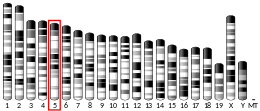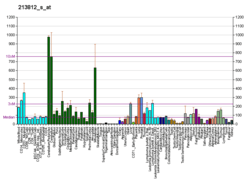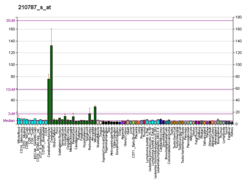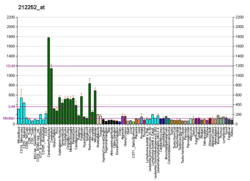CAMKK2
Calcium/calmodulin-dependent protein kinase kinase 2 is an enzyme that in humans is encoded by the CAMKK2 gene.[5][5][6]
Function
The product of this gene belongs to the serine/threonine-specific protein kinase family, and to the Ca++/calmodulin-dependent protein kinase subfamily. This protein plays a role in the calcium/calmodulin-dependent (CaM) kinase cascade by phosphorylating the downstream kinases CaMK1 and CaMK4.[6]
CaMKK2 regulates production of the appetite stimulating hormone neuropeptide Y and functions as an AMPK kinase in the hypothalamus.[7] It also has an important role in the development of hyperalgesia and tolerance to opioid analgesic drugs, through reduction in downstream signalling pathways and mu opioid receptor downregulation.[8][9][10] Inhibition of CaMKK2 in mice reduces appetite and promotes weight loss.[7]
Isoforms
Seven transcript variants encoding six distinct isoforms have been identified for this gene. Additional splice variants have been described but their full-length nature has not been determined. The identified isoforms exhibit a distinct ability to undergo autophosphorylation and to phosphorylate the downstream kinases.[6][11]
References
- GRCh38: Ensembl release 89: ENSG00000110931 - Ensembl, May 2017
- GRCm38: Ensembl release 89: ENSMUSG00000029471 - Ensembl, May 2017
- "Human PubMed Reference:". National Center for Biotechnology Information, U.S. National Library of Medicine.
- "Mouse PubMed Reference:". National Center for Biotechnology Information, U.S. National Library of Medicine.
- Hsu LS, Tsou AP, Chi CW, Lee CH, Chen JY (Sep 1998). "Cloning, expression and chromosomal localization of human Ca2+/calmodulin-dependent protein kinase kinase". J Biomed Sci. 5 (2): 141–9. doi:10.1159/000025324. PMID 9662074.
- "Entrez Gene: CAMKK2 calcium/calmodulin-dependent protein kinase kinase 2, beta".
- Anderson KA, Ribar TJ, Lin F, Noeldner PK, Green MF, Muehlbauer MJ, Witters LA, Kemp BE, Means AR (May 2008). "Hypothalamic CaMKK2 contributes to the regulation of energy balance". Cell Metab. 7 (5): 377–88. doi:10.1016/j.cmet.2008.02.011. PMID 18460329.
- Sánchez-Blázquez P, Rodríguez-Muñoz M, Montero C, de la Torre-Madrid E, Garzón J (February 2008). "Calcium/calmodulin-dependent protein kinase II supports morphine antinociceptive tolerance by phosphorylation of glycosylated phosducin-like protein". Neuropharmacology. 54 (2): 319–30. doi:10.1016/j.neuropharm.2007.10.002. hdl:10261/63344. PMID 18006024.
- Chen Y, Jiang Y, Yue W, Zhou Y, Lu L, Ma L (October 2008). "Chronic, but not acute morphine treatment, up-regulates alpha-Ca2+/calmodulin dependent protein kinase II gene expression in rat brain". Neurochemical Research. 33 (10): 2092–8. doi:10.1007/s11064-008-9690-0. PMID 18408996.
- Chen Y, Yang C, Wang ZJ (January 2010). "Ca2+/calmodulin-dependent protein kinase II alpha is required for the initiation and maintenance of opioid-induced hyperalgesia". Journal of Neuroscience. 30 (1): 38–46. doi:10.1523/JNEUROSCI.4346-09.2010. PMC 2821163. PMID 20053885.
- Hsu LS, Chen GD, Lee LS, Chi CW, Cheng JF, Chen JY (August 2001). "Human Ca2+/calmodulin-dependent protein kinase kinase beta gene encodes multiple isoforms that display distinct kinase activity". J. Biol. Chem. 276 (33): 31113–23. doi:10.1074/jbc.M011720200. PMID 11395482.
External links
- Human CAMKK2 genome location and CAMKK2 gene details page in the UCSC Genome Browser.
Further reading
- Nakajima D, Okazaki N, Yamakawa H, et al. (2003). "Construction of expression-ready cDNA clones for KIAA genes: manual curation of 330 KIAA cDNA clones". DNA Res. 9 (3): 99–106. doi:10.1093/dnares/9.3.99. PMID 12168954.
- Anderson KA, Means RL, Huang QH, et al. (1998). "Components of a calmodulin-dependent protein kinase cascade. Molecular cloning, functional characterization and cellular localization of Ca2+/calmodulin-dependent protein kinase kinase beta". J. Biol. Chem. 273 (48): 31880–9. doi:10.1074/jbc.273.48.31880. PMID 9822657.
- Nagase T, Ishikawa K, Suyama M, et al. (1999). "Prediction of the coding sequences of unidentified human genes. XI. The complete sequences of 100 new cDNA clones from brain which code for large proteins in vitro". DNA Res. 5 (5): 277–86. doi:10.1093/dnares/5.5.277. PMID 9872452.
- Hsu LS, Chen GD, Lee LS, et al. (2001). "Human Ca2+/calmodulin-dependent protein kinase kinase beta gene encodes multiple isoforms that display distinct kinase activity". J. Biol. Chem. 276 (33): 31113–23. doi:10.1074/jbc.M011720200. PMID 11395482.
- Strausberg RL, Feingold EA, Grouse LH, et al. (2003). "Generation and initial analysis of more than 15,000 full-length human and mouse cDNA sequences". Proc. Natl. Acad. Sci. U.S.A. 99 (26): 16899–903. doi:10.1073/pnas.242603899. PMC 139241. PMID 12477932.
- Imai S, Okayama N, Shimizu M, Itoh M (2003). "Increased intracellular calcium activates serum and glucocorticoid-inducible kinase 1 (SGK1) through a calmodulin-calcium calmodulin dependent kinase kinase pathway in Chinese hamster ovary cells". Life Sci. 72 (20): 2199–209. doi:10.1016/S0024-3205(03)00092-4. PMID 12628440.
- Ishikawa Y, Tokumitsu H, Inuzuka H, et al. (2003). "Identification and characterization of novel components of a Ca2+/calmodulin-dependent protein kinase cascade in HeLa cells". FEBS Lett. 550 (1–3): 57–63. doi:10.1016/S0014-5793(03)00817-2. PMID 12935886.
- Gerhard DS, Wagner L, Feingold EA, et al. (2004). "The status, quality, and expansion of the NIH full-length cDNA project: the Mammalian Gene Collection (MGC)". Genome Res. 14 (10B): 2121–7. doi:10.1101/gr.2596504. PMC 528928. PMID 15489334.
- Hawley SA, Pan DA, Mustard KJ, et al. (2005). "Calmodulin-dependent protein kinase kinase-beta is an alternative upstream kinase for AMP-activated protein kinase". Cell Metab. 2 (1): 9–19. doi:10.1016/j.cmet.2005.05.009. PMID 16054095.
- Woods A, Dickerson K, Heath R, et al. (2005). "Ca2+/calmodulin-dependent protein kinase kinase-beta acts upstream of AMP-activated protein kinase in mammalian cells". Cell Metab. 2 (1): 21–33. doi:10.1016/j.cmet.2005.06.005. PMID 16054096.
- Novak G, Seeman P, Tallerico T (2006). "Increased expression of calcium/calmodulin-dependent protein kinase IIbeta in frontal cortex in schizophrenia and depression". Synapse. 59 (1): 61–8. doi:10.1002/syn.20211. PMID 16247765.
- Stahmann N, Woods A, Carling D, Heller R (2006). "Thrombin activates AMP-activated protein kinase in endothelial cells via a pathway involving Ca2+/calmodulin-dependent protein kinase kinase beta". Mol. Cell. Biol. 26 (16): 5933–45. doi:10.1128/MCB.00383-06. PMC 1592798. PMID 16880506.
- Erhardt A, Lucae S, Unschuld PG, et al. (2007). "Association of polymorphisms in P2RX7 and CaMKKb with anxiety disorders". Journal of Affective Disorders. 101 (1–3): 159–68. doi:10.1016/j.jad.2006.11.016. PMID 17197037.
This article incorporates text from the United States National Library of Medicine, which is in the public domain.






